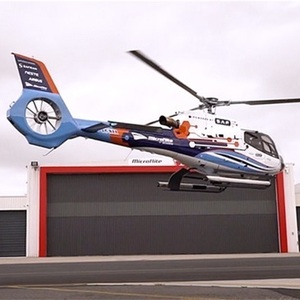Neste: Collaboration achieves helicopter flight with SAF

SOURCE: Neste Corp.
February 28, 2023
BY Neste Corp.
Neste, Airbus, Safran Engines and Microflite, a leading Australian helicopter operator, have jointly operated Australia’s first helicopter flights using sustainable aviation fuel (SAF). On this demonstration flight, an Airbus H130 helicopter powered by a Safran Arriel 2D engine used blended sustainable aviation fuel (SAF) supplied by Neste.
SAF provides a more sustainable, renewable alternative to conventional, fossil based jet fuel. Today’s flight using Neste MY Sustainable Aviation Fuel demonstrates that SAF is a solution available today to significantly reduce greenhouse gas emissions of air travel. The helicopter took off from Moorabbin Airport near Melbourne, and will be expected to fly for a total of 60 minutes over the next few days, and is fueled with a 40/60 blend of SAF with conventional jet fuel.
Witnessing the SAF demonstration flight launch at the Avalon Airshow, The Hon Catherine King MP, Minister of Infrastructure, Transport, Regional Development and Local Government of Australia said “Sustainable aviation fuels represent a tangible opportunity for the aviation sector to cut its emissions in the short to medium term and it is encouraging to see that happening first hand. Our Jet Zero council will work with industry so that we can see more initiatives like this across Australia.”
Advertisement
“As a young and dynamic aviation company with a strong vision to lead excellence in sustainable aviation, we have a fleet of over 20 aircraft conducting passenger, aerial work, and emergency services operations. Our ten-year strategy is to transition our entire fleet to either SAF or electrically powered flight. This Australian-first use of SAF in a rotary-wing aircraft has been achieved through a collaboration with our valued industry partners, and Microflite is proud of the commitment from Airbus, Safran and Neste to join us in leading a sustainable aviation industry,” said Chief Operating Officer Rodney Higgins from Microflite.
“We are pleased to support Airbus, Safran and Microflite on this demonstration flight with the first-ever delivery of Neste MY Sustainable Aviation Fuel to Australia,” said Sami Jauhiainen, vice president APAC, renewable aviation at Neste. “The fuel was delivered to Avalon with the support of our partner, Itochu Corporation. With the expansion of our Singapore refinery starting operations at the end of the first quarter this year, we will be able to produce up to one million tons of SAF annually, ready to support the aviation industry with its emission reduction targets in the Asia Pacific region and globally.”
“The use of SAF is one of Airbus’ levers to reduce carbon emissions, and we are proud to have achieved this milestone SAF flight with long-standing partners Safran and Microflite,” said Stephen Forshaw, Airbus chief representative for Australia, New Zealand and the Pacific. “This demonstration flight underscores Airbus’ commitment to help our customers achieve more sustainable operations. It is an important step in our journey towards decarbonisation, as we join like-minded industry partners for a wider adoption of SAF in flights.”
“This is an important step in our roadmap for the large-scale deployment of SAF,” said Cedric Jochum, Managing Director of Safran Helicopter Engines Australia. “Safran Helicopter Engines turbine range is already certified to run on 50 percent SAF and our team is working to certify operations with 100 precent SAF. When a 100 percent incorporation level is achieved, SAF offers a reduction in CO2e emissions of up to 80 percent.”
Advertisement
Sustainable aviation fuel
Using Neste MY Sustainable Aviation Fuel reduces greenhouse gas emissions by up to 80 percent* over the fuel’s life cycle compared to using fossil jet fuel. Neste MY Sustainable Aviation Fuel is produced from sustainably sourced, 100 percenbt renewable waste and residue raw materials, including used cooking oil and animal fat waste. SAF is blended with conventional jet fuel and works seamlessly with existing fueling infrastructure and aircraft engines.
*) When used in neat form (i.e. unblended) and calculated with established life cycle assessment (LCA) methodologies, such as CORSIA methodology
Related Stories
Avfuel Corp., the leading independent supplier of aviation fuel and services, is expanding its sustainable aviation fuel (SAF) footprint with the addition of a new, strategic supply point in Denver, Colorado—the first of its kind in the region.
CVR Energy Inc. on July 30 reported its renewables segment achieved increased throughput during Q2 despite unplanned downtime but reported a net loss of $11 million. The company expects to retroactively claim the 45Z credit for volumes produced.
Total U.S. operable biofuels production capacity expanded in May, with gains for renewable diesel and a small decrease for ethanol, according to data released by the U.S. Energy Information Administration. Feedstock consumption was up.
SAF-producer XCF Global Inc. on July 28 announced it has signed an exclusive, non-binding indication of intent (IOI) with a renewable fuels infrastructure and feedstock solutions company based in the western U.S.
The abrupt closure announcement by Biox Corp. is the latest example of a failure to secure Canada's domestic energy supply, says Unifor. The Canadian energy union is advocating for simply regulatory changes that could help restart the facility.
Upcoming Events










